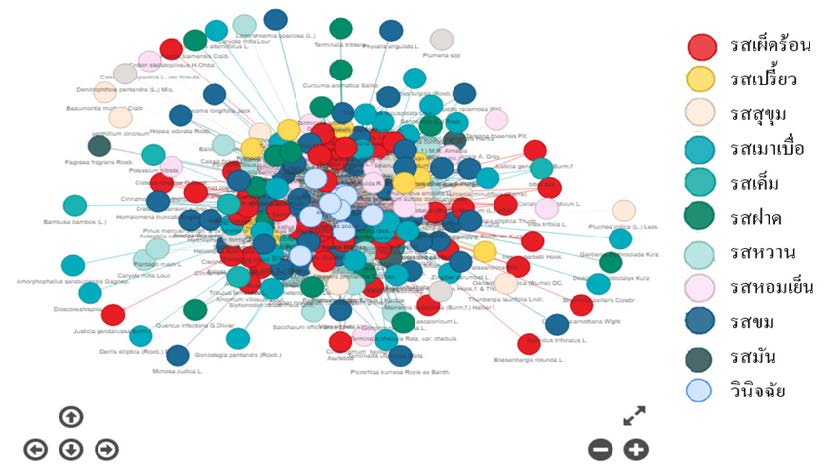Network Analysis of Herbal Medicine Used for Skin Disease at Ayuraved Clinic of Applied Thai Traditional Medicine Siriraj Hospital
Main Article Content
Abstract
Objective: The present study aims to investigate the relationship between herbal medicine tastes and the herbs utilized in the treatment of skin diseases. Additionally, this study examines the application of combined herbal treatments for skin diseases in the Ayuraved Clinic of Applied Thai Traditional Medicine, Siriaj Hospital.
Materials & Methods: This study was retrospective research collected patient data who were diagnosed with Tacho-Phikan (skin diseases) and treated with herbal medicine. Then analyze the relationship between the taste of herbs, herbal medicine, and skin diseases by network analysis, and find relationship herbs that are used together by market basket analysis.
Results: The network analysis revealed that herbal tastes used for treating skin diseases are bitter, spicy, and nauseating. Notably, Smilax corbularia Kunth., Smilax glabra Roxb., Lepidium sativum L., Cuminum cyminum L., Foeniculum vulgare Mill., Nigella sativa L., Nelumbo nucifera Gaertn., Glycyrrhiza uralensis Fisch., Smilax corbularia Kunth. and Smilax glabra Roxb. were found to be commonly used all categories of skin diseases. Additionally, market basket analysis techniques were identify frequently co-used herbs. For example, in acne, Acacia concinna (Willd.) DC., Alum, Bridelia ovata Decne, Tamarindus indica L., and Bauhinia malabarica Roxb. In psoriasis, Acanthus ebracteatus Vahl., Rhinacanthus nasutus (L.) Kurz, Gelonium multiflorum A.Juss., Fibraurea tinctoria Lour, Smilax corbularia Kunth., Smilax glabra Roxb. etc.
Conclusion: This study found that the herbal tastes commonly used for treating skin diseases were bitter, spicy, and nauseating. And found herbs that were used in all categories of skin diseases, including those that were frequently used in combination to treat each skin diseases. These finding may prove valuable in guiding future research and development aimed at simplifying the selection of herbal medicines for the treatment of skin diseases.
Article Details

This work is licensed under a Creative Commons Attribution-NonCommercial-NoDerivatives 4.0 International License.
References
กรมการแพทย์แผนไทยและการแพทย์ทางเลือก.ตำราพื้นฐานวิชาชีพการแพทย์แผนไทย เล่ม ๑ ปรัชญาและพื้นฐานการแพทย์แผนไทย.สมุทรสาคร: พิมพ์ดี; 2561
พระราชบัญญัติวิชาชีพการแพทย์แผนไทย พ.ศ.2556.2556 ราชกิจจานุเบกษา.หน้า 2.
โรงเรียนอายุรเวท (ชีวกโกมารภัจจ์) มูลนิธิฟื้นฟูส่งเสริมการแพทย์แผนไทยเดิมฯ. ตำราเภสัชกรรมไทย.กรุงเทพฯ: พิฆเณศ พริ้นท์ติ้ง เซ็นเตอร์; 2548
มูลนิธิฟื้นฟูส่งเสริมการแพทย์ไทยเดิม และโรงเรียนอายุรเวทธำรง สถานการแพทย์แผนไทยประยุกต์ คณะแพทยศาสตร์ศิริราชพยาบาล มหาวิทยาลัยมหิดล.ตำราการแพทย์ไทยเดิม(แพทยศาสตร์สงเคราะห์ ฉบับอนุรักษ์) เล่มที่ ๑ ฉบับชำระ พ.ศ.๒๕๕๐. พิมพ์ครั้งที่ 3. กรุงเทพฯ: ศุภวนิชการพิมพ์; 2555
สถาบันการแพทย์แผนไทย กรมพัฒนาการแพทย์แผนไทยและการแพทย์ทางเลือก กระทรวงสาธารณสุข ICD-10-TM บัญชีรหัสกลุ่มโรค อาการ และหัตถการด้านการแพทย์แผนไทย. กรุงเทพฯ: สำนักกิจการโรงพิมพ์ องค์การสงเคราะห์ทหารผ่านศึกในพระบรมราชูปถัมภ์; 2558
ดร.เอกสิทธิ์ พัชรวงศ์ศักดา การวิเคราะห์ข้อมูลด้วยเทคนิคดาต้า ไมน์นิง เบื้องต้น. กรุงเทพฯ: เอเชีย ดิจิตอลการพิมพ์จำกัด; 2557 ลบ
Xia P, Gao K, Xie J, Sun W, Shi M, Li W, Zhao J, Yan J, Liu Q, Zheng M, Wang X. Data mining-based analysis of Chinese medicinal herb formulae in chronic kidney disease treatment. Evidence-Based Complementary and Alternative Medicine. 2020 Jan 25;2020. ลบ
Yang DH, Kang JH, Park YB, Park YJ, Oh HS, Kim SB. Association rule mining and network analysis in oriental medicine. PLOS one. 2013 Mar 15;8(3):e59241. ลบ
Reanmongkol W, Itharat A, Bouking P. Evaluation of the anti-inflammatory, antinociceptive and antipyretic activities of the extracts from Smilax corbularia Kunth rhizomes in mice and rats (in vivo). Evaluation. 2007 Mar;29(1):59-67
Wu H, Wang Y, Zhang B, Li YL, Ren ZX, Huang JJ, Zhang ZQ, Lin ZJ, Zhang XM. Smilax glabra Roxb.: A Review of Its Traditional Usages, Phytochemical Constituents, Pharmacological Properties, and Clinical Applications. Drug Design, Development and Therapy. 2022 Jan 1:3621-43.
Na Takuathung M, Wongnoppavich A, Pitchakarn P, Panthong A, Khonsung P, Chiranthanut N, Soonthornchareonnon N, Sireeratawong S. Effects of wannachawee recipe with antipsoriatic activity on suppressing inflammatory cytokine production in hacat human keratinocytes. Evidence-Based Complementary and Alternative Medicine. 2017 Oct;2017.
Mukherjee PK, Mukherjee D, Maji AK, Rai S, Heinrich M. The sacred lotus (Nelumbo nucifera)–phytochemical and therapeutic profile. Journal of Pharmacy and Pharmacology. 2009 Apr;61(4):407-22.
Manohar D, Viswanatha GL, Nagesh S, Jain V, Shivaprasad HN. Ethnopharmacology of Lepidium sativum Linn (Brassicaceae): a review. Int J Phytother Res. 2012;2(1):1-7.
Ahmad A, Husain A, Mujeeb M, Khan SA, Najmi AK, Siddique NA, Damanhouri ZA, Anwar F. A review on therapeutic potential of Nigella sativa: A miracle herb. Asian Pacific journal of tropical biomedicine. 2013 May 1;3(5):337-52.






